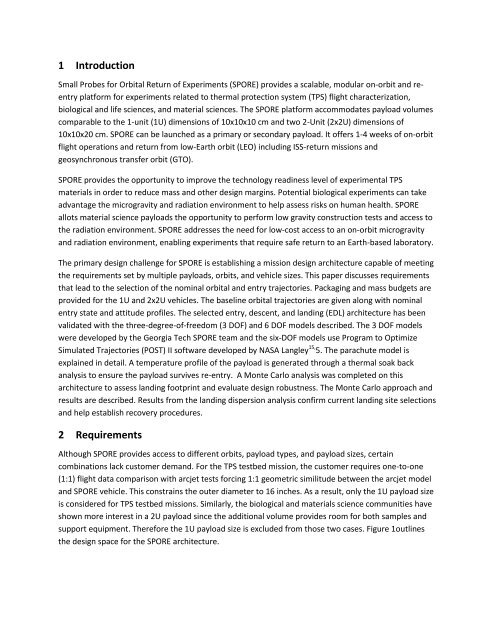SPORE Mission Design - Georgia Tech SSDL - Georgia Institute of ...
SPORE Mission Design - Georgia Tech SSDL - Georgia Institute of ...
SPORE Mission Design - Georgia Tech SSDL - Georgia Institute of ...
Create successful ePaper yourself
Turn your PDF publications into a flip-book with our unique Google optimized e-Paper software.
1 Introduction<br />
Small Probes for Orbital Return <strong>of</strong> Experiments (<strong>SPORE</strong>) provides a scalable, modular on-orbit and reentry<br />
platform for experiments related to thermal protection system (TPS) flight characterization,<br />
biological and life sciences, and material sciences. The <strong>SPORE</strong> platform accommodates payload volumes<br />
comparable to the 1-unit (1U) dimensions <strong>of</strong> 10x10x10 cm and two 2-Unit (2x2U) dimensions <strong>of</strong><br />
10x10x20 cm. <strong>SPORE</strong> can be launched as a primary or secondary payload. It <strong>of</strong>fers 1-4 weeks <strong>of</strong> on-orbit<br />
flight operations and return from low-Earth orbit (LEO) including ISS-return missions and<br />
geosynchronous transfer orbit (GTO).<br />
<strong>SPORE</strong> provides the opportunity to improve the technology readiness level <strong>of</strong> experimental TPS<br />
materials in order to reduce mass and other design margins. Potential biological experiments can take<br />
advantage the microgravity and radiation environment to help assess risks on human health. <strong>SPORE</strong><br />
allots material science payloads the opportunity to perform low gravity construction tests and access to<br />
the radiation environment. <strong>SPORE</strong> addresses the need for low-cost access to an on-orbit microgravity<br />
and radiation environment, enabling experiments that require safe return to an Earth-based laboratory.<br />
The primary design challenge for <strong>SPORE</strong> is establishing a mission design architecture capable <strong>of</strong> meeting<br />
the requirements set by multiple payloads, orbits, and vehicle sizes. This paper discusses requirements<br />
that lead to the selection <strong>of</strong> the nominal orbital and entry trajectories. Packaging and mass budgets are<br />
provided for the 1U and 2x2U vehicles. The baseline orbital trajectories are given along with nominal<br />
entry state and attitude pr<strong>of</strong>iles. The selected entry, descent, and landing (EDL) architecture has been<br />
validated with the three-degree-<strong>of</strong>-freedom (3 DOF) and 6 DOF models described. The 3 DOF models<br />
were developed by the <strong>Georgia</strong> <strong>Tech</strong> <strong>SPORE</strong> team and the six-DOF models use Program to Optimize<br />
Simulated Trajectories (POST) II s<strong>of</strong>tware developed by NASA Langley 15, 5. The parachute model is<br />
explained in detail. A temperature pr<strong>of</strong>ile <strong>of</strong> the payload is generated through a thermal soak back<br />
analysis to ensure the payload survives re-entry. A Monte Carlo analysis was completed on this<br />
architecture to assess landing footprint and evaluate design robustness. The Monte Carlo approach and<br />
results are described. Results from the landing dispersion analysis confirm current landing site selections<br />
and help establish recovery procedures.<br />
2 Requirements<br />
Although <strong>SPORE</strong> provides access to different orbits, payload types, and payload sizes, certain<br />
combinations lack customer demand. For the TPS testbed mission, the customer requires one-to-one<br />
(1:1) flight data comparison with arcjet tests forcing 1:1 geometric similitude between the arcjet model<br />
and <strong>SPORE</strong> vehicle. This constrains the outer diameter to 16 inches. As a result, only the 1U payload size<br />
is considered for TPS testbed missions. Similarly, the biological and materials science communities have<br />
shown more interest in a 2U payload since the additional volume provides room for both samples and<br />
support equipment. Therefore the 1U payload size is excluded from those two cases. Figure 1outlines<br />
the design space for the <strong>SPORE</strong> architecture.
















